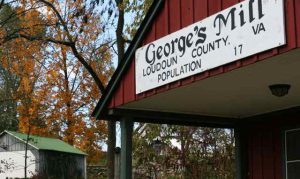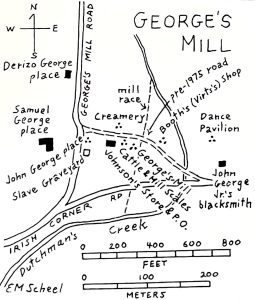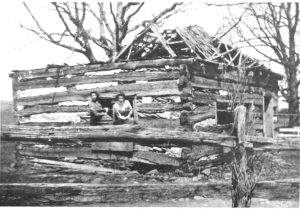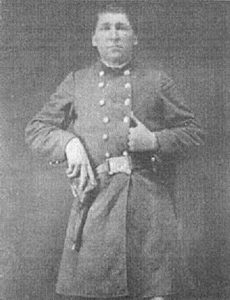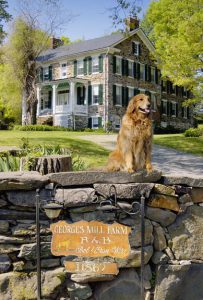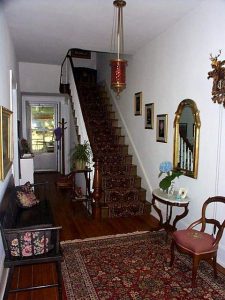Presented by Fran Wire to the Lovettsville Historical Society, May 20, 2018
Editor’s note: Following is the text of Fran Wire’s talk, presented as part of the Lovettsville Historical Society’s Lecture Series. The lecture was videotaped, but the quality was such that we could not post it. After Fran’s death earlier this year (see our appreciation of Fran here), one of her daughters, Jan Wire, found this text and provided it to us, for which we are most grateful.
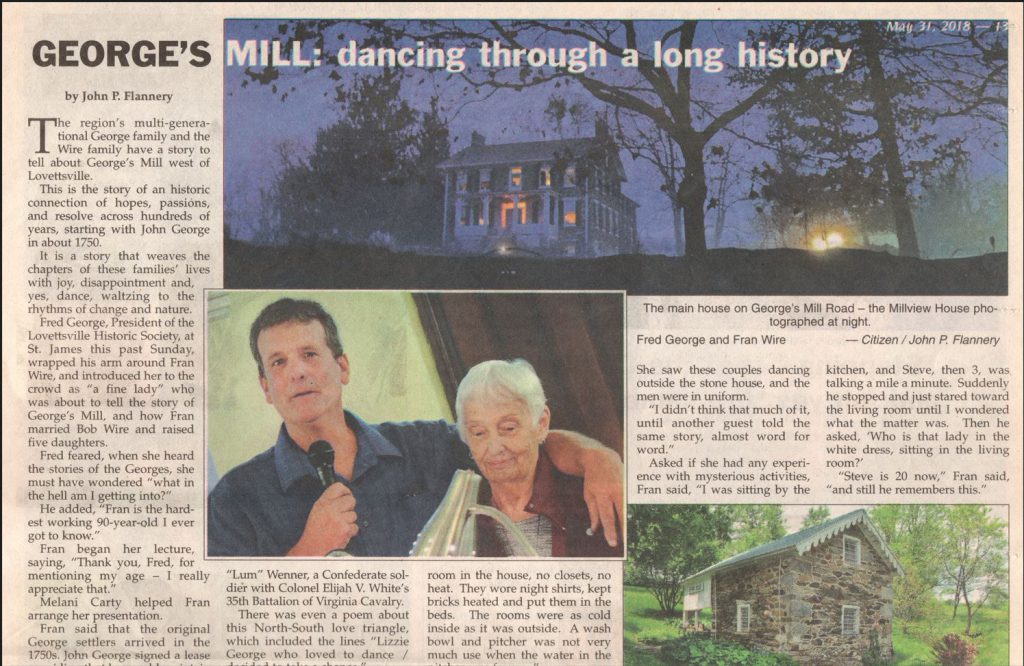
Thank you so much for coming and allowing me to talk about one of my favorite subjects – Georges Mill, and some of the people who have lived here, past and present, and who have contributed so much to its survival!!
You may have heard that recently we have had additions to our family at George’s Mill – 3 of my great grand-children – a girl and 2 boys – making it nine generations of our family at George’s Mill.
We recently counted how many people actually do live here at present, and it was exactly 17 – just what our sign says – Population 17!! …. And we didn’t need to count the goats.
My subject is MEMORIES OF THE PAST … so I am going to take you back to the beginning of what is now George’s Mill Farm and share with you some of the stories and facts that make our history.
As far as we know, the first John George, originally from Germany, arrived here in the 1730s. At that time there was a large tract of land in this area called the Piedmont – over 17,000 acres – available for lease and later for sale. Earlier this land had been sold to Lord Fairfax of England for 2 shillings or twenty-five cents an acre. John George both leased and later bought large tracts of this available land.
Leasing had some interesting requirements:
- Two years after this date to plant upon the premises 100 good apple trees and 200 peach trees at least 30 feet distant from one another, and the same to be enclosed with a good efficient and lawful fence, and keep them all well pruned.
- Erect and build a dwelling home 20 feet by 16 feet and a barn 20 feet square, after the manner of Virginia buildings.
John George married a widow, Elizabeth Eberhart, and they had a son, John Jr.
Court records show beginnings of the first George’s Mill in March of 1774. It was a frame structure.
In 1800, just two miles north of the mill, there was a gold strike, Loudoun’s only known gold strike. Unfortunately, the lessors had retained all mineral rights to the land so we don’t know who actually got the gold or how much was actually found.
John George seems to have consolidated his holdings in November of 1797 – purchasing an additional 240 acres from George Fairfax’s son for $1,725.00.
John George died in 1808. His will was interesting as it left to his wife one third of his estate plus 2 sheep and a cow named Joyce. His will also specified that a horse should be found for her whenever she had need of one.
John Jr. inherited the mill and was to pay to his mother 600 pounds ($1500), find her a house and “garten” and find her firewood and sow her one-fourth acre of flax and grind yearly and every year – and give her 15 bushels of wheat – 5 bushels of Indian corn and 100 weight of pork yearly.
John George Jr.’s wife was Elizabeth Smith. Their son, Samuel Wilhelm George, was born December 6, 1819. John George Jr. died in 1856. John George Jr.’s will indicated that he had 4 slaves – two boys (Simon Peter and Perry), one girl (Kitty), and a woman (Harriett). We understand from previous members of the family that at least two of them were buried in the wooded lot across from the stone house. Up to the present time we have not been able to locate the area as the markers were made of wood and are long gone. The grave was described as “by the old oak tree.” The lot is now a forest of old oak trees. We hope in the future we may be able to find the right location and replace the lost markers in honor those that are buried there. (John George Jr.’s son Samuel George was not a slave owner.)
John George Jr.’s will also mentioned the old George school house which had been built at the entrance to his home (now the Riddlemoser home). It was a pay school where parents paid the schoolmaster directly.
Later, during the Civil War, Samuel George’s children attended this school. (Samuel George was married to Eliza Catherine Grubb) The school grounds were a favorite meeting place for the Union Troops (the 6th NY Calvary) who were camping on that part of the George property during the entire last winter of the Civil War.
It was a favorite meeting place because the soldiers were able to enjoy the company of the young girls attending school there. These meetings resulted in winter sleigh rides, church festivities and especially dancing. Also, it was said, that certain officers were known to often have dinner with the George family.
So it wasn’t long before Samuel George’s daughter, Leah – better known as Lizzie – and Lt. Peter Haskins were raising eyebrows among family and friends! Especially since Haskins was known to have a fiancé (chosen by his prominent father) back in New York, and Lizzie a local boyfriend – [Christopher Columbus] “Lum” Wenner, who was a Confederate soldier! Lum was not a happy camper about Lizzie and Haskins, and he was known to spy on them. So, rather than tell you the outcome of that long story, which is recorded in letters written by Haskins to Lizzie, I would instead like to read you a poem, written by my sister, Jean – which says it all.
Poem: “Lizzie’s Romance” When Virginia voted to secede, most Loudoun resident voted “yes.” Just Waterford and Lovettsville said, “no, the North is best” The Georges, those at George’s Mill, preferred the Union too. And when some Yanks camped on their land, they made friends with a few. Lizzie George, who loves to dance, decided she would take a chance And ask some Yankee boys to come, to dance, and tell where they were from Lieutenant Haskins caught her eye, she danced with him that night, Not long ‘til they became a pair and planned a future bright. But Haskins had one thing to solve – a New York girl named Emma, Who up to now was Haskin’s girl and that was a dilemma. And Lizzie’s beau, Columbus – Lum for short, Thought he was Lizzie’s number one, and often came to court. So Haskins traveled to New York and apparently was freed, Since, as he wrote to Lizzie – he and Emma did “secede” Then back again to George’s Mill, once more in Lizzie’s favor Once more to dances, sleigh bells, and winter fun to savor. And in between his wartime work, he came to Georges Mill To dance and romance Lizzie, as sweethearts always will. He sent her many letters, letters she saved all her life, Making clear that he intended to have her as his wife. Then he fell sick and was released into his father’s care. His father was a congressman (must have helped to get him there) His father had urged Emma’s case, apparently with force. For something changed for Haskins that made him change his course. Then Haskins wrote to Lizzie and this is what he said, “I’m back again with Emma and soon we will be wed.” Yet later still he wrote again, “I’m coming back to you, It’s you I still love after all—Emma and I are through.” But when he came, it was too later and Haskins was forlorn. For Lizzie was engaged to Lum, and he was left to mourn. He then rejoined the Army, to fight the Indians in the West, And that’s the last we know of him, no way to know the rest. Lizzie, though, survived all this and soon she married Lum, Lived all her life with Lum and kids on the farm that she came from.
So Lizzie’s romance brings us to the end of the Civil War. One of Peter Haskins’ letters to Lizzie at this time mentions that he was present at Appomattox when peace was declared … the war was finally over.
However, before we leave war-time stories, there is one local character I want to mention, since I was told by older family members that this “renegade” worked at George’s Mill when he was a teenager. I am referring to the well-known character John Mobberly. Before the war he worked from time to time at George’s Mill Farm. He tended Samuel George’s fine horses. My sister Jean wrote a poem depicting Mobberly’s life. See what you think!
Poem: John Mobberly He came from out the Short Hills, from the rugged mountain land And he knew those Short Hill mountains like the back of his own hand You may think that Grant’s a genius, or praise Robert E. Lee But folks don’t know just what to think ‘bout Private Mobberly. He was big, and bad and brave and bold and he knew horses too He rose astride with style and pride, they say he stole a few He dashed right into Yankee camps with his small band of men He stole a lot, some Yanks he shot, then galloped out again. He fled into the Short Hills where he could not be found They say he couldn’t read or write but his shooting was renowned. Although his heart was with the Rebs (or that’s what some folks think) He double-crossed the Rebels too and didn’t even blink. He loved the girls, they loved him back, for all his dashing ways But there were men who had a plot to end his outlaw days. They lured him to a local farm with promise of a horse And planned to hide inside the barn, then shoot without remorse. That’s what they did, while they were hid and him a sitting duck. “Oh God, I’m dead!” is what he said as he ran out of luck. Just twenty when he breathed his last and though he is long gone, Was he hero or renegade? His legend lingers on.
After the war ended in 1865, the Samuel George family resumed building their new home – Millview. It was located in the large area where Samuel’s father, John George, Jr., had planted their garden. This is the house that still stands today.
Samuel George’s sons were expected to find and haul appropriate stone from the fields and mountains to the home site. It was reported that they got pretty tired of the job.
The Roller brothers were the builders and J.W. Wright the carpenter and architect. During this time, they also built a stone barn, a frame corn crib, and a mill which had a stone foundation. Although the mill eventually fell in during the Depression, the stone foundation still exists. Their work was completed around 1869 and the family was finally able to move in.
There are features of the house that remind one of the abilities of those builders and planners. The layout of the house itself – not only to afford a beautiful view, but also to provide protection from the weather, and still have as much sunshine as possible (a feature that might be needed today as we turn to solar power!).
Areas were left open for gardens and orchards, and they used native trees for building, for fence posts, and various other needs.
We had a visitor recently who was an architect. He pointed out the long narrow front hallway that run from the front door through the hall to the back porch, providing a breezeway to allow as much air as possible during hot months.
Other interesting features are the high ceilings, and the large windows with rounded sides to allow in as much light as possible. We also noted that the doors have locks on them that were dated around 1860 – and they still work!
Of course, when the house was first built, there was no electricity, no running water, no bathrooms, no closets, no heat except for fireplaces. It was so cold some winters that everyone wore heavy clothes inside. They heated bricks in the fireplace to warm their beds before retiring. Their bed clothes often included night caps to keep their heads warm, heavy night shirts, and warm stockings.
The mill was a very important part of the farm and community since it was used by many neighbors in the area as well. It was a grain and grist mill, and there was a large scale on the property for weighing lumber, grains, and large animals from time to time.
The farm at that time was nearly self-sustaining, as they were able to produce most of their needs themselves. The only items they needed to buy were sugar, salt, and coffee. Even the coffee they sometimes made themselves from the mahogany trees on the property.
Samuel George was also known to have a stable of fine horses – riding, hunting, and buggy horses, as well as trained work horses (some for sale).
He also found it profitable to make deals with some Washington, D.C. horse and buggy owners to pasture their weary and overworked horses during the summer for a specific time in the lush pastures of his farm.
The trip back and forth to the city required two full days so Samuel and his helpers found it necessary to stop each way at their favorite roadside tavern for refreshment and sleep. It was reported that the tavern was well known for its excellent refreshments.
On April 5, 1884 Samuel and Eliza George sold one acre of land across from the old George school house to trustees of Public Schools of Lovettsville District for $125. This was five times the usual price of schoolhouse land in Eastern Loudoun.
It was the late 1880s and times were changing. Most people were becoming more prosperous and had some free time. Music and dancing were the favorite pastimes of not only the young, but seemed to involve even the older generation. Just a short time before, revivals and church were the only pastime, along with short rides in the buggy to visit friends and family.
Samuel George’s youngest daughter Ella had taken dancing lessons while away at school. She was known to often give parties at Georges Mill. A local newspaper reported that one particular party, given in the middle of winter with a blizzard outside blowing snow about fiercely, hosted 20 couples and that no left until the wee hours of the morning. The sheet music and other memories were saved by Ella all her life.
There was always someone to play the piano that was the family parlor. Ella often played herself, but much preferred to dance instead. Sometimes guests brought other instruments and there was lots of dancing and food.
Ella married Robert Johnson – better known as “the Colonel”—in 1890. A house was built for them right next to the mill – with wood from trees on the farm. They had three daughters – Frieda, Columbia, and Esther.
The three sisters had many memories of growing up. They had an uncle, Fairfax Wright, who was a doctor. He lived in Pennsylvania and visited George’s Mill every summer. He would gather up all the children in the family, including cousins, for a health examination. This was not a pleasant time, and the children would scatter and hide as long as they could. On one occasion, a cousin was diagnosed with bad tonsils and Dr. Fairfax removed them on the back porch. With all the children witnessing the procedure, he removed the tonsils with a spoon.
The sisters and their cousins also hated to see the dentist come for a visit as well, as he brought his foot-controlled grinder to repair any decay he might find in their teeth.
The visitor they did enjoy was a seamstress who would come with her sewing machine and stay for two weeks when she would make their dresses and other needed clothing for the family.
Robert Johnson was a Postmaster in DC and since Ella made it clear that she didn’t intend to ever leave the farm to live in DC or anywhere else, (she usually got her way) Johnson petitioned the government for a new Post Office at George’s Mill, and the new Post Office opened in 1891. We still have the stampers used in the Post Office.
Ella at one time became the Post Mistress. Most customers rode up on horseback and one of Ella’s daughters would run out with their mail! Esther said that sometimes they would give her an apple or a piece of candy!
During that same period, they operated a grocery store in the front room of their home.
When the mill closed, they polished the floor and held summer dances there. It became a very popular place to spend time. However, there was so much loud music and laughter that members of the local church were praying that the mill would either burn down or wash away – which it did in 1920 during a big storm. However, that did not stop the dancers, for they built a large dance floor across the creek and continued their fun!
The late 1880s were not all music and dancing though, indicated by an article published in March of ’89.[i] The article involves Ella’s father-in-law – Charles W. Johnson. (Read more about Charles Johnson here.)
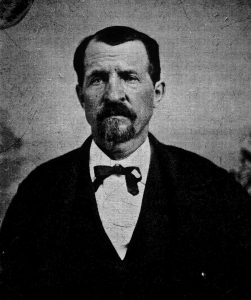
An Ugly Fight
All About a Post Office
There has been a war in Lovettsville; at least there have been “rumors of war.” These rumors, which may not be correct in details, indicate that Messrs C.W. Johnson and J. Buryer,[ii] both Republicans, assisted by their sons, indulged in an ugly fight a few days ago. It is reported that Mr. Johnson me Mr. Buryer upon the street and accused him of being a party to a scheme recently worked, by which M. Chinn, the democratic postmaster at the place, resigned and a republican was appointed – presumably for the purpose of keeping the office in Chinn’s store. To this Mr. Buryer made certain admissions, whereupon Mr. Johnson berated him so severely that blows and a scuffle followed, and very quickly the two were lying in the gutter with Johnson on top. The latter was proceeding to punish his adversary when Mr. Buryer’s son rushed up with a stone, with which he struck Mr. Johnson on the head, causing the blood to spurt in a stream from the wound. At this juncture Mr. Buryer was seen to get out his knife, but before he could use it, the men were separated by others who had been attracted by the affair. All this happened in less time, perhaps, than it takes to mention it, but it was a serious and unfortunate affair. And it is hoped that the reports of it are exaggerated.
There were, of course, hard times ahead for the family and the whole nation – three wars to endure as well as the Great Depression. However, at that time they were able to raise crops, can food from their gardens, raise pigs, milk cows, hunt, and catch fish. In this way they were able to carry on.
It seemed to be a family tradition at Georges Mill that younger members of the family would move in with older members to help take care of them
When needed. So the Johnson family moved up to the stone house when that time came. Eventually the three sisters—Frieda, Columbia, and Esther–were left to manage the farm, which Esther was mostly doing already since Frieda and Columbia were teachers. The three sisters lived many years together.
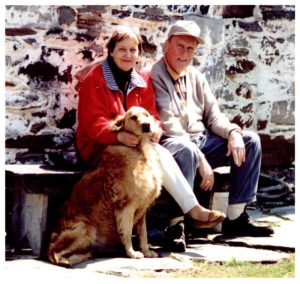
Frieda and Esther never married, but Columbia married her local sweetheart—Charles Wire. They had a son, Robert Wire, who I am sure a lot of you knew. Bob and I married when we were 19. We had five daughters! (It seems girls run in the family!) How lucky can you get? Our daughters spend a lot of time visiting the farm and Bob and I visited as much as possible.
Eventually, after her sisters died, Esther was left alone and found she needed help. After staying with Bob and me for a while, Esther decided that she just wanted to spend the rest of her life at Georges Mill. So after working over 50 years with the B&O and C&O RR, Bob decided to retire and spend as much time as possible visiting with Esther and helping her run the farm. Bob worked on fixing up the stone house, which by that time needed a lot of attention. He and George Hawes (under the watchful eye of Esther) spent a lot of time repairing walls and floors, etc., etc.
Esther lived to the ripe old age of 101, fulfilling a lifelong devotion to the farm and her family. She devoted her life to taking care of her parents and other family members.
After Esther died, Bob and I realized that we had to find some way to keep the farm going. We decided to open a Bed and Breakfast, which turned out to be beneficial not only to bring income, but also to meet so many interesting people – some of whom came as guests and left as friends.
So, all is well now at Georges Mill Farm. Having four of my daughters living on the farm is a blessing, as they help me out with the B&B which makes it possible for me to continue on.
So we hope you will check us out – stop for a visit, spend a night or two, or just get a tour. We would love to have you!
[i] This story was reported in the Loudoun Telephone of March 22, 1889.
[ii] Jacob Boryer, a blacksmith, was a Union soldier in the Loudoun Rangers during the Civil War. In 1864 he was arrested for shady commercial dealings. He was one of the Loudoun Rangers who were authorized to capture or kill John Mobberly in April 1865. –editor.


